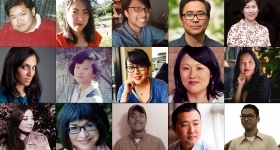A 21st century form of fascism is rising in the United States and around the world, hand in hand with increased racist and misogynist violence and oppression. Demagogues like Trump are fabricating a mythic past, trading on white men’s nostalgic longing for a country of racial purity that never was. It is into this context that Mia Ayumi Malhotra’s Isako Isako, winner of the Alice James Award from Alice James Books, arrived this summer. Beautifully and strangely evoking a mythic femme figure who carries us through the river of time, Malhotra’s debut is part of a groundswell of artists of color countering today’s rising fascism through imaginative evocations of the past and present realities of communities of color.
Malhotra, through the figure of Isako, reminds readers that many of our mothers and our grandmothers also lived through dangerous times. Her poems insist on the continued corporeal realities of being a woman-identified person of color in this country — both the bodily threats and the endurance of spirit. By conjuring the voices and experiences of generations of women in an ever-present now, she illuminates the difficult reality of the present while also offering us the possibility of a different future.
For time is not always linear in Isako Isako. Malhotra has compared her sense of time to the way rivers run. In an interview on the Lit Fantastic podcast, she says, “the continuity of the river … parallels with the ways that I conceive of family history and generational time. How one generation flows seamlessly into the next.” To achieve this sense of generational flow, Malhotra has written into being a character called Isako who is not one particular person, but a distinctly Japanese American figure representing collected wisdom and experiences of generations of women. She is female lineage embodied, whose “truth marches on.”
To acknowledge such a lineage is to acknowledge a certain responsibility, which Malhotra takes seriously. If we are linked — physically, spiritually, through stories and through memories — to the generations that have come before, we must carry both the weight and the wisdoms they have passed to us. Isako Isako is an attempt to do just that.
***
The incarceration of 120,000 people — most of whom were U.S. citizens — during World War II might have seemed like ancient history at some point. But this summer, as the U.S. government ramped up its inhuman incarceration of families crossing the U.S./Mexico border, and as the Supreme Court upheld Trump’s “Muslim ban,” it became clearer than ever that the past is never really past. Discrimination, incarceration, targeting of groups based on their race or place of origin is flaming high, as it was during World War II.
At the same time, Malhotra reminds us that time carries on without stopping. She has said she wrote Isako Isako in part as an elegy to her two grandmothers, one of whom was interned during World War II (the other lived in Japan during the war). The book can also be read as an elegy to her grandmothers’ generation: the last generation of internees — those who were young children or teenagers when they were removed from their homes and locked behind barbed wire. They are passing on, and it is up to their children, grandchildren, nephews and nieces, to keep their stories alive.
Coincidentally (or maybe not), I first read Isako Isako as I flew from Boston to L.A. to attend my uncle’s funeral. He was of this generation, a child during the internment. At the funeral, the pastor’s eloquent eulogy included a mention of how, as an adult, my uncle always felt that his prosperity and material comfort were simply on loan. He knew from experience that, at any moment, everything could be taken away from him and his community.
In Isako Isako, that moment of utter loss is ever-present. The second “poem” of the book is a replication of the evacuation order, familiar to those who have studied Japanese American history, and printed in whole. In May 1942, evacuation notices appeared overnight across the West Coast, tacked up on lampposts and walls. It notified “all persons of Japanese ancestry” that they would “be evacuated from the area” in a week. Malhotra places this evacuation order immediately preceding the first Isako poem.
I’ve skimmed this notice many times as a historical document, but I had not read every word, never meditated on its language as if it were a poem. But as I did so here, I was struck by how forcefully bureaucratic language can sanitize inhumanity, can make it seem official and inevitable. I imagined what it must have felt like for my uncle’s parents to read it, for my uncle to watch his mother pack his belongings in a suitcase that his small hands could lift. And it seemed entirely plausible that something like this could appear again, today targeted at another group, written in official language that conveys shocking instructions: Pack only what you can carry. Bring bedding. Leave your pets. We’re at war, and you are the enemy.
When these notices suddenly appeared in the streets of Seattle, Tacoma, Portland, San Francisco, L.A., they began a collective experience of displacement and trauma that is still running through the Japanese American community. Malhotra is not simply providing historical context by including the notice at the start of the book. She is also asking us to pay close attention to the literal signs of collective oppression. And to notice the resulting trauma as it appears in the bodies of grandmothers, aunts, mothers and perhaps our own: “fractured, never healed.”
Throughout Isako Isako, Malhotra reflects the fracture of collective trauma through the use and breakage of form and syntax. “Polytrauma,” for example, becomes a linguistic demonstration of how violence shatters bodies and psyches. She shreds the line with slashes and disrupts meaning with excerpted language from a variety of sources on war and trauma.
… / fragments from hostile device
noted in chest cavity / you shooting at them / puts nerve endings
outside the body / puncture wound from 50 cal. shell entering left trapezius
like mad dogs about to die / trained to hit the gas
Many of the poems in Isako Isako explore the effects of war on the body: literal war as well as the war of cancer and illness. If the body is “a form through which we pass,” this temporary corporeal status is evoked through unmoored lines that drift across the page. Sometimes unpunctuated, often surreal, these poems demand we understand, through disrupted language, how tenuous bodies are: “Is lady lie in bed organs pulled from chest cavity heart lungs and kidney… Is lady branch to smaller and smaller divisions which end in clusters of alveoli”; how vulnerable: “a woman’s body / drifts back into the bay splits red / when opened / stomach curried with a wire brush–”; how they can be blown away like ash: “Isako your uncle whispers something about the city bombed like ash your sister and her two girls drift back to you on the wind.”
***
But while the individual body in Isako Isako may be easily broken, the spirit is tough and enduring — because it is part of the generational collective as Malhotra conceives it. She declares, “a new grammar may be necessary” to articulate the depth of this kind of collective wisdom and our individual places within it. Indeed, the best poems in this collection are wild in their language and inquiry into new ways of understanding memory, history and being.
As part of her project of de- and re-constructing a grammar, Malhotra forces us to understand the pronoun “I” in a new and disorienting way: “In the supple whip of her spine I senses she was once contained by another form. But I has no recollection of the moment but the present.” The I is many, multiple and ever-present.
Which leads me to a line in the poem “The History of Isako”: “Behind barbed wire all questions run to one.” I ruminated for a while on what this question might be. When you are locked up by the country to which you profess loyalty, when you are targeted because of your race, what is the single question that encompasses all of the rage, sorrow and fear you might feel?
I found the answer/question toward the end of the book: “How can a life be lost if it was never yours.” If time is a river where generations merge into each other, Malhotra suggests, there is no loss because there is no singularity. We do not own our own lives; we are part of a larger experience, a larger struggle, a larger whole. The entire book, in some ways, is a meditation on what it means to live a life that is not only yours but ours also.
In “Isako, Last Spring,” from which the title of the collection comes, Malhotra explores this concept to stunning effect. The repetition of “Isako” can be read in turn as an address to an individual person as well as an address to the generational collective:
Isako Isako have you run to your end.
Isako Isako is there an end and if so is it near.
Isako Isako will I see you again.
Isako Isako you are mostly bone. My hand on your spine as you lower onto the white couch.
Isako Isako I turn the pages of your life and find you on every spread. Eyes solemn beneath schoolgirl bangs. Foot turned to accentuate the line of your body. An Isako for every age.
Malhotra’s poems insist that there is no single, comprehensive story that can be told about any one person or people. “You can close your mouth, / but somewhere else, another will open.” In so doing, these poems provide a counter to the isolation of individual and collective trauma of being a woman in a patriarchal, capitalist society; of being a person of color in a white supremacist society.
Isako refuses isolation. We are all Isako. Isako is all of us. And we have much to learn from her/ourselves/each other.
If today’s forces of fascism and systemic racism are attempting to erase the lived reality of all of us who are not white, straight or male, Malhotra, in her debut collection, has helped to arm us with some defense. The concept of Isako — the collected wisdom and strength of generations of women of color — becomes a powerful weapon with which to fight our erasure, declare our collective presence and carve out a wiser, more compassionate world built on the wisdoms of all the Isakos in our lineages.










Comments